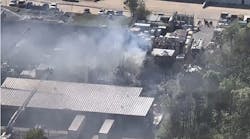New York City's Great Fire of 1835 was a firefighter's nightmare that ignited a political crisis and helped modernize the fire department.
In the early 1800s, New York then confined to lower Manhattan Island south of 18th Street grew haphazardly. Rickety brick and wood structures crowded together on narrow passageways and residents relied on gas for light and coal fires for heat.
On the freezing cold night of Dec. 16, this deadly combination sparked a blaze that eventually consumed 21 blocks and almost 700 buildings. Around 9 o'clock the contents of a ruptures gas pipe came into contact with a coal furnace in the dry goods shop of Comstock & Andrews at 25 Merchant St., an alley one block from Wall Street.
Then, as now, the city's business district centered on Wall Street. Located near the bustling wharves and docks, this wealthy neighborhood was home to such landmark institutions as the Post Office and the ornate Merchants Exchange, site of the stock market.
Peter A. Holmes, an insurance company watchman, first discovered the blaze. Investigating, he "found the whole interior of the building in flames from cellar to roof." Caches of whale oil and turpentine stored in adjacent shops hastened the fire's spread.
Moments later, businessman Philip Hone found a situation that "exceeded all description; the progress of the flames, like flashes of lightening, communicated in every direction, and a few minutes sufficed to level the lofty edifices on every side" of the street.
As the fire slashed toward the East River, the city's 1,500 volunteer firemen assembled at their stations and pulled their cumbersome hand pumpers through panic-choked streets toward the scene. There they found a stubborn inferno that was impossible to control, since the crippling cold froze their hoses and paralyzed their equipment.
A strong gale fueled the flames as explosions rained debris onto the streets. The New York Transcript described "walls tumbling to the ground, and the firemen, worn out from their exertions and almost discouraged from further efforts, vainly striving to make head against the flames, which seemed to mock all human skill and power."
Residents feared that the fire would level Manhattan and spread to Brooklyn. The water shortage, along with primitive communications, dangerous conditions and a lack of relief, took its toll on the exhausted volunteers.
Still, not all was lost. Witnesses credited legendary Foreman Zophar Mills and the men of Eagle Engine Company 13 with containing the blaze's western flank. After the roof of the Tontine Coffee House ignited, Mill's troops tried to douse the blaze from the street but could not reach. The company then piled up tables and barrels in the street, climbed the makeshift lift and extinguished the fire.
Even with this victory, four hours after the initial spark the New York Evening Post reported that "there is no knowing where the flames will be stayed ... the hose of many of the engines are frozen and useless ... The scene grows worse and worse."
Circumstances became so desperate that Chief Engineer James Gulick and Mayor Lawrence Cornelius decided to save the city by destroying it. At 3 A.M. they dispatched a group of men to fetch gunpowder from the Brooklyn Navy Yard in order to blow up buildings in the fire's path.
Chaos swirled about the firemen as they battled into the morning. Shop owners scrambled to rescue whatever they could and hired men on the spot to pile goods into the streets, which attracted mobs of looters. Constables chased thieves through the rubble, rounding up about 400 suspected lawbreakers. Vigilantes hung an accused arsonist from a lamppost and the mayor called out the militia to maintain order.
The Great Fire raged through the morning and burned itself out by 3 o'clock the following afternoon with the help of several explosions engineered by Gulick and assistants to arrest the fire's spread.
Units from Jersey City and Newark, NJ, and even Philadelphia arrived to wet down the ruins. A week later the Transcript reported that Philadelphia's bravest, "those gallant and generous fellows," were "escorted to the wharf by a great number of our citizens, who gave them three loud and hearty cheers."
Remarkably, only two people died in the disaster, which exposed the consequences of unchecked growth. Property losses approached $40 million, an enormous sum in those days and aid poured in from across the region.
The blaze also marked the beginning of the end of the city's volunteer fire corps. Posing as the people's protectors, politicians immediately tightened building codes, mandated wider streets and criticized the firemen's performance during the tragedy.
Assistant Alderman Henry Townsend called the department a "weak and inefficient body, incapable of performing its duties, and in a state of almost entire disorganization." In part, Gulick fell victim to the Council's political designs. Democrats controlled the city government and Gulick, an avowed Whig who commanded legions of influential voters, was a thorn in the party's paw.
As rumors circulated that the Common Council sought Gulick's removal, firemen defended their honor by holding meetings and issuing press releases. A Christmas Eve assembly attended by engineers, foremen and assistants issued a proclamation to refute the "many slanderous and illiberal remarks which have been made, in reference to the late fire."
Upon arriving at the scene, which "baffled description," the men realized they had been "called upon to perform a series of laborious duties unparalleled in the annals of our department, and unknown to those of any other in our country." The firefighters tried their best to conquer the flames, which progressed with "dreadful rapidity."
Clearly stung by the attacks, the department's leaders offered to resign. "Rather than longer submit to the many illiberal, cruel and ungenerous remark with which we have been assailed during the past few days," they wrote, "we would rather forego the privilege attendant upon our station, and sacrifice forever the laborious duties which for many years many of us have been engaged in."
Two of the city's six daily newspapers lines up behind the volunteers. A Transcript editorial praised the men as "daring, intrepid and active fellows ... combating against difficulties which it was utterly impossible they could surmount."
The New York Commercial Advertiser commented that "never, upon any occasion, when danger and consternation surrounded them upon every hand, have they displayed more cool and discriminating judgement than upon that memorable night, in which they felt ... a weight of responsibility which can only be known by those that watched the anxiety which ... marked their countenances as they realized the fallacy of their exertions to avoid the ruin that was inevitable."
By May 1836, however, nothing could sway the Mayor's Committee on Fire and Water. When word of Gulick's ouster reached the city's fire stations, 800 men marched on City Hall and resigned en masse. Those who remained refused to answer alarms until the council replaced Gulick's successor, John Ryker Jr. One fire company's ledger referred to Ryker's appointment as an act "contrary to the wishes of a great Majority of the Acting members of the department and the reasons given for the removal of Ja. Gulick and the charges preferred against him we consider but lame excuses and malignant falsehoods."
Eventually, Ryker was relieved of his post, which still did not satisfy the men. The department displayed its disgust for city officials by transforming into a formidable political force that elected Gulick to the office of City Register by a landslide. Victory celebrations included a mile-long torchlight parade down Broadway.
Gulick and his men were vindicated and over the ensuing decades reorganization of the fire department remained a political hot potato until practical realities and new technology eventually forced the creation of the city's professional force.
The tall buildings that replaced those destroyed in the 1835 fire strained the limits of the period's primitive wooden engines, which required 26-man crews to operate a manual pumper that generated a feeble stream.
During the 1840s and 1850s, infernos became more frequent and potentially destructive. One visitor to New York commented that fire-watching was "like deciding to go to the theater to see a play… and sure enough, we did not have to wait long for the spectacle." Clearly, the city needed a better system to fight the problem.
By the early 1860s, inventors perfected the horse-drawn steam engine. Outperforming the old-fashioned gooseneck engines and requiring less manpower, the steam age signaled the arrival of the professional Fire Department of New York City in 1865.
New York's Great Conflagration of 1835 the young nation's first disaster bound the country together in tragedy and changed ways of life for the city's citizens and its firefighters.
Marc Ferris is a writer and historian with an interest in the fire service. He was project editor for the book Encyclopedia Of New York.







